
DIY blacksmithing and knife-making
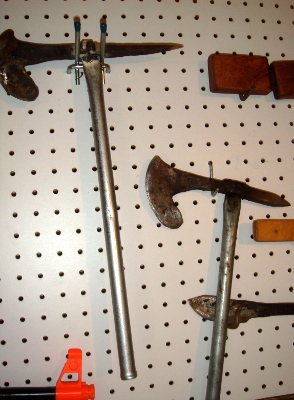 For a long time I was in search of
knives that fit my hands, my
use, and my budget. Frankly there wasn't much out there that
didn't
cost an arm and a leg, so I looked into how to make my own knives.
For a long time I was in search of
knives that fit my hands, my
use, and my budget. Frankly there wasn't much out there that
didn't
cost an arm and a leg, so I looked into how to make my own knives.
I
found a great video from Purgatory
Ironworks on youtube that
walks you
through how to make a Brake Drum Forge. By simply taking an old
brake
drum & some metal piping you can create a working forge. I
called
around the local auto repair shops and was offered 3 drums in just 5
minutes, but selected the largest for ease of work. After
installing
the simple black pipes to the bottom and attaching a hairdryer for air
supply I was off and running. On other youtube videos that Trent
at
Purgatory does, he also shows you how to make your own charcoal, a
great thing for a beginning blacksmith to know how to do.
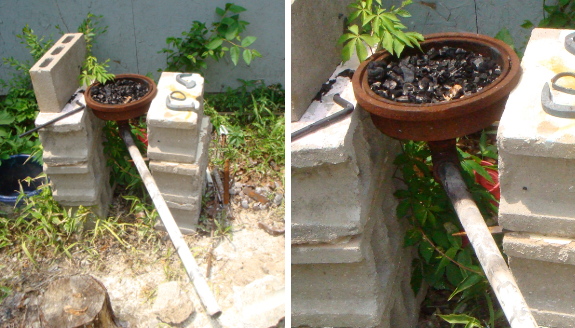
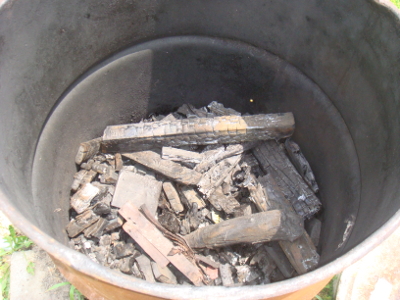 So once I got my forge built and
my charcoal made, the next step was to make an anvil. I
visited our local scrapyard and bought not only a 24" piece of railroad
track, but a 1" thick 6x15" piece of plate steel and a 2" square tubing
piece to weld onto it. By welding the plate steel and the tubing
on
the track, I was able to get a smooth flat surface with a hole to be
used for driving holes through red hot metal.
So once I got my forge built and
my charcoal made, the next step was to make an anvil. I
visited our local scrapyard and bought not only a 24" piece of railroad
track, but a 1" thick 6x15" piece of plate steel and a 2" square tubing
piece to weld onto it. By welding the plate steel and the tubing
on
the track, I was able to get a smooth flat surface with a hole to be
used for driving holes through red hot metal.
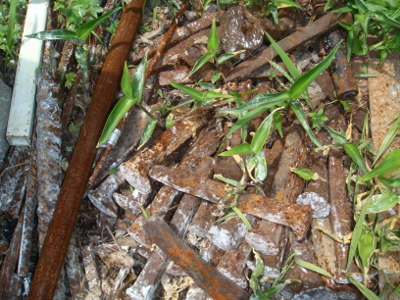 With my charcoal
going, I simply turn my hair dryer on, get the fire and coals nice and
hot, and put my metal in to begin. The metals I usually use are
old
hand files that are now dull and have little value to most people, so
they can be obtained pretty cheap from a flea market or garage
sale. I
also use alot of old railroad steel found near local tracks by my
parents. Most of the time it's railroad spikes but every so often
there
are other random pieces of steel. The railroad spikes are then
divided into 2 piles, the
regular spikes and the high carbon spikes (you can tell by the HC on
the head of the spike). The high carbons are used on tracks in
places
of stress or curves.
With my charcoal
going, I simply turn my hair dryer on, get the fire and coals nice and
hot, and put my metal in to begin. The metals I usually use are
old
hand files that are now dull and have little value to most people, so
they can be obtained pretty cheap from a flea market or garage
sale. I
also use alot of old railroad steel found near local tracks by my
parents. Most of the time it's railroad spikes but every so often
there
are other random pieces of steel. The railroad spikes are then
divided into 2 piles, the
regular spikes and the high carbon spikes (you can tell by the HC on
the head of the spike). The high carbons are used on tracks in
places
of stress or curves.
From the forge, the metal is
extremely hot and
usually an orange to red color. I then take my tongs and put the
piece
on the anvil, then using my 3# Cross Peen or my 2# ball peen hammers, I
start to shape, draw out, and work the metal to my desired
product. It
does take many heatings and repeated sessions on the anvil, but in the
end the product is then 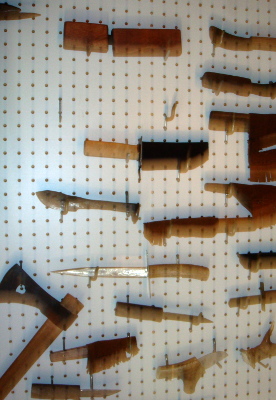 quenched in used motor oil to cool
it. I then
clean all of the oil off the item, polish it to the smoothness I want
for
that item (higher polish for knife blades, less for tomahawks, tools,
and other items) and temper it in an oven for around an hour.
quenched in used motor oil to cool
it. I then
clean all of the oil off the item, polish it to the smoothness I want
for
that item (higher polish for knife blades, less for tomahawks, tools,
and other items) and temper it in an oven for around an hour.
Once the metal is out of the
oven, it's usually set in a handle, I make a leather sheath,
and it's done. The only thing I'm actually paying for now
everytime I
use my forge is the little electricity to run the dryer/blower, and if
you're worried about that you can use a hand bellows just like in the
1800s. I've made knives, tomahawks and hatchets, chisels,
mountain man
flint strikers, and other items out of the scrap steel found along the
tracks or out of used files. The next goal is to forge weld some
cables into billets to make knives, and maybe even a sword out of.
Editor's
Note: I asked David how much his startup costs were and he estimates it
cost him $20 to make the forge, $13 for tools he didn't already have,
and $38 to build the anvil; everything else was supplies he already had
on hand. I suspect the setup would have paid for itself nearly
immediately if he charged the friends who have put in orders for
specific items like a lightweight hatchet/tomahawk with a hammer head,
Japanese style blades, and filet knives for processing game.
Want more in-depth information? Browse through our books.
Or explore more posts by date or by subject.
About us: Anna Hess and Mark Hamilton spent over a decade living self-sufficiently in the mountains of Virginia before moving north to start over from scratch in the foothills of Ohio. They've experimented with permaculture, no-till gardening, trailersteading, home-based microbusinesses and much more, writing about their adventures in both blogs and books.
Want to be notified when new comments are posted on this page? Click on the RSS button after you add a comment to subscribe to the comment feed, or simply check the box beside "email replies to me" while writing your comment.

What I would like to know is how much of the steel is lost in the forging process? I talked with a prehistoric blacksmith reenactor who once made his own iron using sediments (iron oxides) from a local river. That was a fairly involved process with a relatively low yield. Have you ever weighed a piece before and after forging?
WRT forging temperatures, I saw a demonstration by the aforementioned blacksmith, where he heated the material in a charcoal fire powered by bellows until it was almost white-hot and began to sparkle (at that which point the iron starts burning).
It's a good idea to use charcoal. Coal can contain impurities that can affect the steel negatively, epsecially sulphur and phosphorus.
Phil --- That's an idea that's more my speed. (Although I think that Mark is intrigued by the DIY forge. Maybe we'll try it in a decade or so when the garden is so well mulched it doesn't take over our lives in the summer. )
)
Roland --- Care of tools is an excellent point, and one we need to pay more attention to. I've read about sharpening shovels, etc., and I never seem to get around to it, probably because I don't really know what I'm doing. I think that hand tool care would be right up there with learning to use a scythe if I had a local expert I could apprentice with.
It is not that difficult. You can start with your kitchen knives. Since these are almost always stainless steel, they respond very well to a honing steel treatment. You can do that every day if you wish. Only if the knives are really blunt (say, once a year) you need to get a dual coarse/fine sharpening stone. An artificial stone (bonded abrasive) is the cheapest and works fine. A piece of wet factory glass (float glass) with a piece of fine waterproof sandpaper on it also works very well.
Grind the knife at an approximately 20 degree angle on both sides (lay it flat on the stone and tilt it up by 20 degrees), that should be fine for most kitchen knives. You can make knives sharper by using a smaller angle, but that makes the edge more vulnerable. If keeping a constant angle is difficult for you, use a sharpening jig.
Knives or tools that rust are carbon steel, which is harder and holds an edge better. Don't use a honing steel here, just a sharpening stone.
Personally I like to use water on the sharpening stone, to keep the metal cool and carry away the swarf.
Phil, I completley agree with you on using sawblades or lawnmower blades for blade making. Frankly ive used old discarded cake spreaders, discarded butcher/kitchen knives, hand saw blades, skilsaw blades, and a variety of other discarded items to make blades and other items. While I 100% support taking care of your tools and items, most of the stuff I personally use to make new items are items that are discarded or sold because they no longer are needed for their original purpose (old files that have become dull, saw blades that are now dull...) and most people would rather throw away or scrap their items than resharpen or rework. Its the modern disposable way of thinking for most people, which while sad it does lend itself to those of us who reuse, recycle, or repurpose those items discarded and bring them not only to new life, but reduce what I actually "buy" from the stores.
Kind of a use the whole buffalo way of thinking with items, might as well find a use for items rather than throw them out or discard them.
Daddy --- That's a topic I've pondered for a while. Is it worth holding onto old skills just because humanity might need them some day? Sure, I'm glad that we still have shovels even though big agriculture has pretty much made these hand tools obsolete, but that's because shovels fit a niche in my life. If the shovels had all disappeared, chances are I would have read about them in a book and found some way to make one after all. I'm not sure that a skill is worth learning just to turn the farm into a living history museum. But I'm still pondering....
Roland --- I do tend to sharpen our knives...well, the ones we use to kill chickens, right before we do the deed. We have a cheapo knife sharpener that has the angle built in --- you just run the blade through it a few times on the coarse side, then on the fine side. Probably not good enough for great knives, but it works fine with our so-so knives.
We have a cheapo knife sharpener that has the angle built in --- you just run the blade through it a few times on the coarse side, then on the fine side. Probably not good enough for great knives, but it works fine with our so-so knives.
I was wondering about the high carbon steel distinction David made in his post, and I'm glad you added that tidbit about it.
David --- The recycling element is what I love most about your hobby and post! (Although "hobby" makes it sound like less than it is.) Of course, we'd all love it if our culture stopped churning out disposables, but while we live in the current world, I think that it's a noble occupation to take those throwaways and turn them into useful tools.
A lot of steel (if not most of it) is recycled these days, mainly because it is much cheaper than refining ore. Steel does not lose its properties when recycled.
BTW, if you ever have the opportunity to see impression die forging, go and have a look. It is very impressive, seeing white-hot steel being formed in only a couple of strokes.
There are some nice videos on youtube as well.